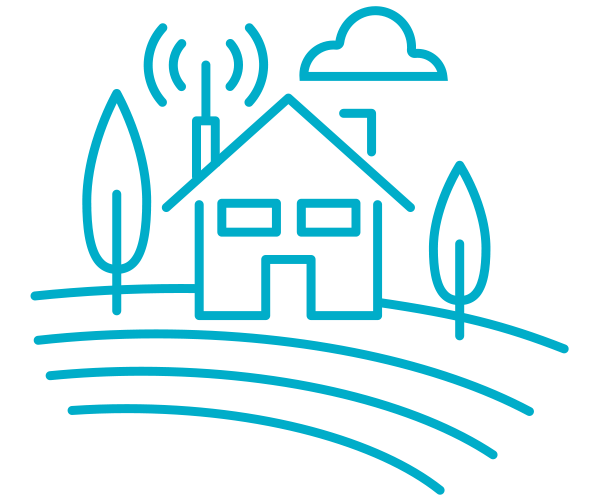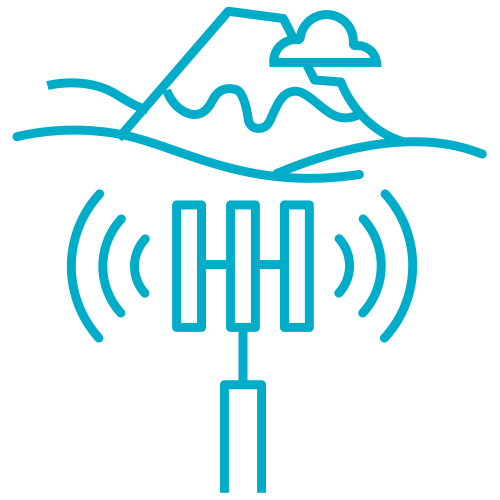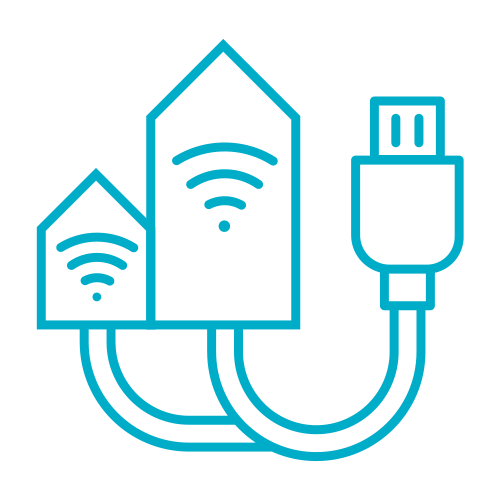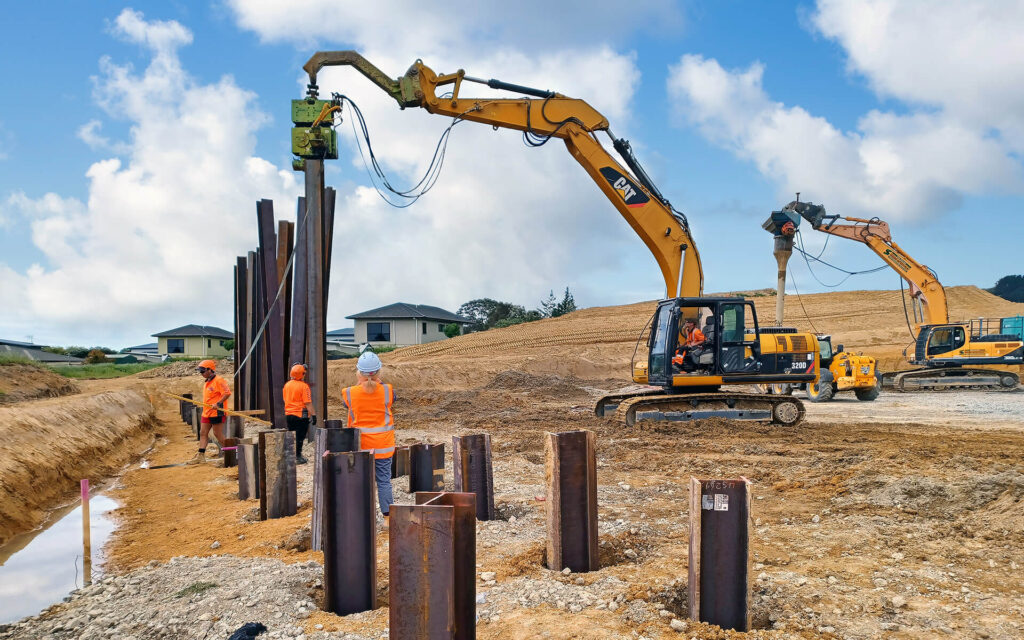The administration of the Infrastructure Acceleration Fund was transferred to National Infrastructure Funding and Financing Limited (NIFF) from Kainga Ora effective from 1 July 2025. Effective from this date, National Infrastructure is now party to the IAF Funding Agreement and relevant IAF Housing Outcomes Agreements on behalf of the Government.
The Infrastructure Acceleration Fund (IAF) provides councils with funding to support the delivery of critical infrastructure (transport, water and flood management projects) needed to enable housing development and commits councils and developers to building homes in areas of high housing need.
The IAF is designed to bridge the funding gap between what councils can afford and how much infrastructure costs, while also requiring developers to pay their fair share.
IAF programme update
Critical infrastructure projects supported by the Infrastructure Acceleration Fund (IAF) continue to be rolled out in communities across the country.
IAF funding allocations
Nationally, $908 million in Government funding from the IAF has been allocated to critical infrastructure projects in cities and towns across the country, from the Far North to Otago.
Combined, these IAF-supported projects are expected to enable around 30,000 to 35,000 new homes for New Zealanders. The IAF is supporting delivery of infrastructure projects in multiple regions, including large urban areas and smaller centres with high housing needs.
REGIONAL FUNDING
REGIONAL BREAKDOWN OF IAF-SUPPORTED PROJECTS
Read more about the IAF-supported projects in the regional breakdown below.
Kaikohe
- IAF funding agreed: $23 million
- New homes expected to be enabled: 365
Housing developments on three sites in Kaikohe will be accelerated by $23 million in IAF funding, which will be used for flood management and significant wastewater and stormwater upgrades to improve the current network and provide for future growth.
The Far North District Council expects the IAF-funded infrastructure will enable 365 new homes in the area, to provide much-needed home ownership opportunities for mana whenua and the wider community. Both public and papakāinga homes are among the planned housing outcomes.
Kawakawa
- IAF funding agreed: $25.6 million
- New homes expected to be enabled: 310
A road extension and significant water infrastructure upgrades in the Far North town of Kawakawa will receive $25.6 million from the IAF, to enable hundreds of new homes to be built in the area and address the significant housing shortfall.
Far North District Council expects the infrastructure projects funded by the IAF will enable 310 new homes, including homes within the proposed Te Mataora development delivered by Ngā Kāingamaha o Ngāti Hine Charitable Trust. The Trust’s plans for the development include aged-care apartments and more affordable homes, to create an intergenerational community.
Whangārei
- IAF funding agreed: $10.3 million
- New homes expected to be enabled: 3,000
Key transport upgrades in Whangārei will be supported by $10.3 million from the IAF. The projects receiving funding include a new bridge in the suburb of Kamo, to help increase access to and open up a much wider area for housing development. The new bridge will replace an existing single-lane timber bridge, which has stalled development plans to date. IAF funding will also be used for a new roundabout on State Highway One with an arterial road and shared user path, connecting planned development areas in Springs Flat with services, education and employment opportunities.
The IAF-funded infrastructure projects are expected to support the delivery of up to 3,000 additional homes in the medium to long-term.
Auckland (Mt Albert)
- IAF funding agreed: $113.2 million
- New homes expected to be enabled: 4,000
IAF investment of $113.2 million will fund Carrington Road-related infrastructure upgrades to support the large-scale urban development at Pt Chevalier/Mt Albert, Auckland led by the three Tāmaki Makaurau Rōpū.
It is expected this infrastructure will support the delivery of approximately 4,000 new homes over nearly 40 hectares of land.
The IAF funding will be used for the widening of Carrington Road and associated upgrades, which include dedicated bus lanes, cycle lanes, intersection improvements, and safe pedestrian crossing points, all within the extended Carrington Road corridor identified in the Unitary Plan. The transport solutions funded by the IAF will also enable future development and intensification in Mt Albert and surrounding suburbs.
Auckland (Ōrākei)
- IAF funding agreed: $7.3 million
- New homes expected to be enabled: 469
The project to upgrade the intersection between Kupe Street and Kepa Road, led by local hapū Ngāti Whātua Ōrākei with funding from the Infrastructure Acceleration Fund (IAF), will help deliver more planned housing in the Ōrākei area.
IAF will invest up to $7.3 million of the total project costs, with Ngāti Whātua Ōrākei also contributing funding towards the total cost.
It is expected the funding will help accelerate the delivery of essential infrastructure to support the development of at least 469 homes over the coming years, while contributing to the potential for further housing growth and intensification in the Ōrākei area. This includes more homes by developers and Ngāti Whātua Ōrākei – who are also working to build more homes for whānau near Ōrākei Marae. The upgrade will improve safety and access, in particular toPourewa Reserve, benefitting the wider community.
Hamilton
- IAF funding agreed: $150.6 million
- New homes expected to be enabled: 4,140
IAF funding of $150.6 million committed to support intensification of Hamilton’s central city. The funding will be used for critical infrastructure projects to facilitate further development in the area – including a new water reservoir and pump station as well as local water connections and upgrades.
The funding is expected to support around 4,140new homes, located close to employment, education and transport to enable a ‘20- minute city’ where people can live, work and play in the same space and reduce their need for travel.
Ngāruawāhia
- IAF funding agreed: $5.32 million
- New homes expected to be enabled: 200
The Galbraith Street catchment area in the Waikato town of Ngāruawāhia will receive $5.32 million for three waters and transport infrastructure. The Waikato District Council expects this will enable approximately 200 new affordable and market homes within walking distance to the town centre and local schools, while also contributing to the potential for further housing growth on adjacent land.
Tauranga (Tauriko West)
- IAF funding agreed: $80 million
- New homes expected to be enabled: 2,000
In the fast-growing Bay of Plenty region, $80 million from the IAF has been allocated to major transport and water upgrades to unlock housing in the priority growth area of Tauranga’s greenfield Tauriko West. Tauranga City Council expects the funding will enable around 2,000 new homes, which could include public, affordable and market housing.
The transport upgrades funded through the IAF will increase connectivity to the city centre and nearby Tauriko Business Estate, while developing a long-term network to support urban growth within the wider Western Corridor.
Tauranga (Te Papa Peninsula)
- IAF funding agreed: $67.9 million
- New homes expected to be enabled: 1,600
Tauranga’s Te Papa Peninsula will benefit from $67.9 million of IAF funding, which is allocated to critical infrastructure upgrades to unlock housing and support intensification in the area.
The IAF funding will contribute towards Stage Two of the Cameron Road corridor upgrade – an important arterial road that runs through the centre of Te Papa Peninsula and connects the outer suburbs to the city centre.
Tauranga City Council expects the IAF-funded infrastructure, which also includes further transport upgrades and water supply extensions, will enable 1,600 new homes within connected and vibrant communities.
Rotorua
- IAF funding agreed: $84.6 million
- New homes expected to be enabled: 3,080
Almost $85 million has been committed to stormwater solutions in Central and Western areas of Rotorua, including reserves and green spaces up through the Utuhina and Mangakakahi Streams. With the help of developer partners, Rotorua Lakes Council expects this infrastructure to enable over 3,000 dwellings.
Ōmokoroa
- IAF funding agreed: $38.4 million
- New homes expected to be enabled: 2,580
Investment of approximately $38.4 million will fund a key intersection between State Highway 2 and Ōmokoroa Road, providing safe access to the Ōmokoroa peninsula and catering for the next 15 years of anticipated growth for the town.
This upgrade is expected to enable approximately 2,500 homes, with a mix of standalone homes, affordable homes and medium density housing.
Gisborne
- IAF funding agreed: $4.3 million
- New homes expected to be enabled: 458
The Taruheru catchment area in Gisborne will see a $4.3 million IAF investment in key water projects and roading upgrades. Gisborne District Council expects these works will enable public, affordable and market housing, as well as a potential housing site for mana whenua housing and a wellness centre.
Hastings
- IAF funding agreed: $18.5 million
- New homes expected to be enabled: 4,000
An $18.5 million investment in Hastings will improve road access and resolve capacity constraints in the district’s wastewater network. This was a joint application between Hastings District Council and Heretaunga Tamatea Settlement Trust. The Council believes the IAF funding will enable around 4,000 new homes across multiple developments, including Māori housing on several papakāinga developments.
Waipukurau
- IAF funding agreed: $10.9 million
- New homes expected to be enabled: 950
Central Hawkes Bay District Council will receive $10.9 million, to fund critical infrastructure required to unlock the land for new housing within the Waipukurau South Growth Precinct. The Council believes the funding will enable up to 950 homes to be built within the Precinct – supporting much of the urban growth needed in the district.
The infrastructure works include various transport improvements, several kilometres of new pipeline for wastewater and water supply, a new water reservoir, and major stormwater upgrades that are critical to realising the full potential of the development area.
Napier
- IAF funding agreed: $12.4 million
- New homes expected to be enabled: 400
Maraenui in Napier will receive $12.4 million for crucial flood management work, which Napier City Council believes will provide network capacity for an additional 400 new homes, including public and affordable.
New Plymouth
- IAF funding agreed: $1.8 million
- New homes expected to be enabled: 300
Six housing developments in Ferndale, New Plymouth, will see an approximately $1.8 million investment in upgrades to the water supply and transport network, which the New Plymouth District Council believes will allow for up to 300 new homes over the long-term, with multi-modal transport options.
Whanganui
- IAF funding agreed: $1.95 million
- New homes expected to be enabled: 340
The extension of Carson Street in the Whanganui suburb of Castlecliff will receive $1.95 million for associated transport and three waters infrastructure. The infrastructure works will extend the road to enable up to 340 additional homes in the area, with plans for intergenerational housing.
Pahiatua
- IAF funding agreed: $880,000
- New homes expected to be enabled: 30
Development plans for a former school site in the Tararua town of Pahiatua will be supported by $880,000 from the IAF, to help meet the need for more housing. The IAF funding will be used for new wastewater, stormwater and freshwater infrastructure, which the Tararua District Council expects will enable at least 30 new homes on the Rangitāne-owned development site.
Ōtaki
- IAF funding agreed: $29.3 million
- New homes expected to be enabled: 1,040
In the Kāpiti Coast town of Ōtaki, a joint application between Māori landowners, Council and private developers succeeded in securing approximately $29.32 million of IAF funds to upgrade three waters infrastructure and roading. This funding is expected to enable over 1,000 papakāinga, affordable and market homes.
Lower Hutt
- IAF funding agreed: $98.9 million
- New homes expected to be enabled: 3,520
Lower Hutt’s RiverLink and Valley Floor intensification project will receive $98.9 million for major stormwater upgrades, including approximately two kilometres of new stormwater pipeline, pumping stations and outfalls. As part of a wider network response, Hutt City Council believes the infrastructure will unlock development and provide capacity for around 3,500 new homes.
Motueka
- IAF funding agreed: $1.2 million
- New homes expected to be enabled: 200
A new wastewater main, stormwater upgrades and a new roundabout in Motueka will be supported by $1.2 million from the IAF. It is expected the funding will help accelerate the delivery of around 200 new homes, which could include affordable, public and papakāinga housing.
Nelson City
- IAF funding agreed: $36.4 million
- New homes expected to be enabled: 1,025
Around $36 million has been committed to support the intensification of Nelson’s central city. The IAF funding will be used for transport and three waters infrastructure to unlock approximately 1,025 new homes, which the Nelson City Council expects could result in a ten-fold increase in the number of central city residents.
Hokitika
- IAF funding agreed: $3.5 million
- New homes expected to be enabled: 110
Plans by the Westland District Council to develop part of the Hokitika Racecourse for new housing will be accelerated by $3.5 million in IAF funding, which will enable homes to be built much sooner than would otherwise be possible.
The transport and three waters infrastructure funded by the IAF is expected to enable around 110 new homes, which is expected to include more affordable housing and public homes for older people.
Westport
- IAF funding agreed: $13.6 million
- New homes expected to be enabled: 400
The South Island town of Westport will receive $13.6 million from the IAF for transport and water infrastructure, which will support housing delivery and help increase community resilience against future climate events.
The IAF-funded infrastructure will enable up to 400 new homes to be built within the Alma Road development area, which aims to provide the Westport community with increased housing options on naturally raised land away from existing flood-prone areas.
The infrastructure projects include new stormwater, freshwater and wastewater mains, an arterial road and bridge upgrade, and a new cycleway and footpath.
Christchurch
- IAF funding agreed: $30.9 million
- New homes expected to be enabled: 1,400
IAF funding of $30.9 million for new transport infrastructure, wastewater and freshwater upgrades will accelerate housing delivery within a large development area in Papanui, Christchurch.
The wastewater infrastructure will reduce the occurrence of overflows in high rainfall events.
It is expected the infrastructure funding will enable around 1,400 new homes located close to the city centre, educational facilities, public transport, and other community amenities.
Rangiora
- IAF funding agreed: $5.7 million
- New homes expected to be enabled: 1,300
Rangiora will receive $5.7 million for transport and three waters projects, which is expected to accelerate the delivery of around 1,300 affordable and market homes within a large housing development in northeast Rangiora.
Kaikōura
- IAF funding agreed: $7.8 million
- New homes expected to be enabled: 400
Kaikōura is receiving almost $7.8 million for projects expected to enable approximately 400 houses across two different sites – Vicarage Views, a new subdivision situated within the Kaikōura urban area, and Ocean Ridge an existing subdivision to the west of the town accessed by State Highway 1.
Lake Hāwea
- IAF funding agreed: $24 million
- New homes expected to be enabled: 880
Lake Hāwea will receive $24 million for three waters infrastructure, including a new reticulated wastewater treatment connection, which will improve environmental outcomes and increase network capacity to help meet anticipated growth in the area. It is expected the IAF-funded infrastructure will ultimately enable around 880 new homes, including more affordable housing, both within the Longview Special Housing Area and general housing stock in line with QLDC’s demand projections through to 2041.
How were the projects chosen for funding? Minister of Housing & Urban Development and Minister of Finance
The IAF was launched by the Government as a contestable fund in June 2021.
The evaluation and commercial negotiation process was led by and involved input from other Government agencies. Final funding decisions were made by the Minister of Housing & Urban Development and Minister of Finance
All proposals were assessed against key criteria set by Cabinet:
- Housing outcomes (40%): how will the Proposal, if delivered, contribute to the housing outcomes that are the purpose of the IAF?
- Impact of funding (20%): how critical is this funding to advancing the infrastructure and housing development?
- Cost and co-funding (20%): how cost effective is the Proposal and is everyone paying their fair share?
- Capability and readiness (20%): if funding is approved, how certain is it that the project will advance, and at what pace?
Landowners are expected to pay their fair share, and funding from councils and others is required for the housing developments to be realised.
The commercial negotiation phase was completed in early 2023. The IAF programme is now in the delivery phase whereby councils are in the process of designing, consenting, and constructing the infrastructure projects. Funding from the IAF is paid in arrears as key milestones are achieved – many of which will take multiple years to complete.
Frequently asked questions
Councils (and one iwi), as funding recipients and project owners, are responsible for delivering the IAF-supported infrastructure. They work in partnership with developers and iwi, who will build the homes.
National Infrastructure Funding and Financing manages the contracts entered into with councils, developers and iwi to track progress on the IAF-supported infrastructure projects and housing developments, ensuring milestones are reached and outcomes achieved.
IAF supported infrastructure projects are now underway throughout the country.
It’s important to note timeframes are dependent on the extent of the infrastructure required and may change as the projects progress. As with all large-scale projects there are key activities (i.e. consenting, land acquisition, funding confirmation) and detailed planning requirements to be met before physical works can commence.
Funding is made available to councils incrementally as their infrastructure projects reach key milestones.
The infrastructure works funded by the IAF are expected to enable a range of housing developments throughout Aotearoa, including intensification and greenfield developments with a mix of housing types. Affordable, market, social and papakāinga homes are among the planned housing outcomes identified by councils.
More information
- General enquiries: Please email the IAF Team on [email protected]
- IAF media enquiries: Please direct all media enquiries about the IAF [email protected]















